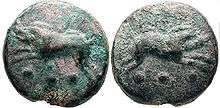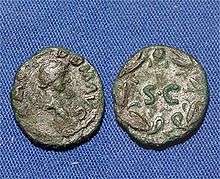Quadrans



The quadrans (literally meaning "a quarter") or teruncius ("three unciae") was a low-value Roman bronze coin worth one quarter of an as. The quadrans was issued from the beginning of cast bronze coins during the Roman Republic with three pellets representing three unciae as a mark of value. The obverse type, after some early variations, featured the bust of Hercules, while the reverse featured the prow of a galley. Coins with the same value were issued from other cities in Central Italy, using a cast process.
After ca. 90 BC, when bronze coinage was reduced to the semuncial standard, the quadrans became the lowest-valued coin in production. It was produced sporadically until the time of Antoninus Pius (AD 138–161). Unlike other coins during the Roman Empire, the quadrans rarely bore the image of the emperor.
The Greek word for the quadrans was κοδράντης (kodrantes), which was translated in the King James Version of the Bible as "farthing".[1] In the New Testament a coin equal to one half the Attic chalcus was worth about 3/8 of a cent. In Mark's gospel, when a poor widow gave two mites or λεπτα (lepta) to the Temple Treasury, the gospel writer noted that this amounted to one quadrans.[2]
See also
References
- ↑ Greek Lexicon :: G2835 (NKJV)
- ↑ Mark 12:42
External links
-
 Media related to quadrans at Wikimedia Commons
Media related to quadrans at Wikimedia Commons

